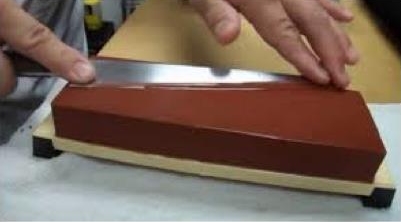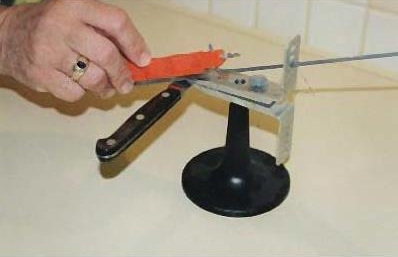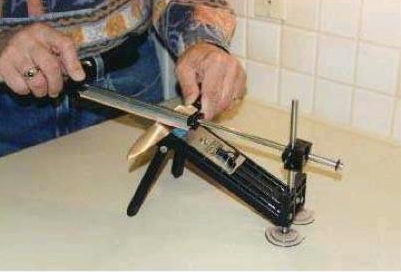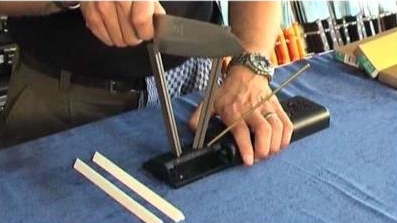

A Good Example of Human Factors Engineering
I've been a Human Factors Engineer for 30 years and I still get asked what that means. The definition comes easy enough: it's the science of applying knowledge of human capabilities and limitations to the design of systems, equipment, and facilities. But that's not usually enough to explain what Human Factors Engineers actually do, so over the years I've collected some examples to help clarify that definition.
A few months ago I came across one example that shows how we can design either to the limitations or to the capabilities of humans. This example is related to something I've been doing even longer: cooking.
There is nothing more important to cooking, and to safety while cooking, than a good, sharp knife. However, even with honing at each use, knives eventually need to be re-sharpened. Re-sharpening with the traditional whetstone method (shown below) is a difficult task for humans to master. Most people simply cannot hold the knife at the correct angle in both the pull and push operations or repeat the same angle each time they re-sharpen unless they practice for years and do it often.

To try to address this issue for those who need to re-sharpen only occasionally (i.e., everyone who owns a kitchen knife), some people have tried to design sharpening "systems." Systems like those from Lansky and Gatco (shown in the two images below) use a jig to hold the knife in place while a guide system sets and holds the angle of the sharpening stone.


These units work fairly well, though there are still some issues. There is still a bit of a learning curve for these systems. The knife must be placed in the jig the same way each time. If it's placed a bit further in or out, the angle is not what is intended. Attempts at sharpening become edge re-profiling instead, which takes longer and shortens the life of a blade.
In addition, even if the knife is set in the jig correctly, the angle is accurate only in a short side-to-side portion of the knife directly in front of the guide. As you move farther and farther off center from the guide, the angle becomes more and more shallow. As a result, you really need to reposition the blade on the jig multiple times (which increases the chance of error), or accept a knife with a slightly varying angle down the blade.
These designs work by trying to compensate for the limitations humans have in performing this task. However, it is possible to design for the capabilities humans have in performing this task.
Humans have special sensors in our optical system both in the eye and in the optical center of the brain. We have receptors in our vision that only detect movement and edges. There is an area in the brain that looks for faces. We even have specialized centers of our brain to look for hairy legs (yes, its true). The sensors that are useful in knife sharpening are the ones that only detect vertical and horizontal lines.
Have you ever noticed you can walk into a room and tell if a picture on the wall is not perfectly straight? You can't specify the angle on which it's hanging, just that it's not perfectly straight. Because of these special sensors in our optical system, we can tell with amazing certainty if something is perfectly horizontal or perfectly vertical. We can almost feel when our vertical sensor is active and our horizontal sensor is completely inactive, or vice versa.
After that, we're a bit iffy. We can't tell if it's 5 degrees off center, or see the difference between 6 degrees and 7. We can, however, feel a perfect balance of the two specialized sensors and detect when a line exists at exactly 45 degrees. Consider the rod sharpening system such as the one in the image below.

Systems like this one from Spyderco hold the sharpening rods at a fixed angle. The user is expected do the rest; to slide the knife down the rods while holding the blade perfectly vertically. This is precisely the type of task that a human can do with amazing precision. As a result, this system can be mastered in a matter of minutes and tends to produce good quality results from almost anyone, on any size blade, every time it's used.
By the way, the system shown in the picture includes two knife blade angles for different types of knives and one angle for scissors. If you turn the unit over, you can place the rods in a horizontal position and try your hand at the expert knife sharpening mode. It also comes with two brass rods, shown in the picture, to protect the user's hand from being cut if the blade were to slip off the rod. After all, we may be expert at detecting vertical lines, but we're only human.

